Exploring Innovation Barriers in Leading Commercial Companies Report
VerifiedAdded on 2021/04/17
|7
|2958
|113
Report
AI Summary
This report provides a comprehensive analysis of innovation management within the commercial services sector, with a particular focus on the barriers that hinder the development and implementation of potentially disruptive innovations. It begins by defining innovation and its significance in a business context, highlighting the importance of new concepts, products, and services. The report emphasizes the exploration of internal barriers to innovation, differentiating them from external factors. The report then examines various aspects of innovation, including the differences between traditional and modern methods, the impact of company size, and a case study conducted at a multinational bank. It also explores the literature regarding innovation in commercial facilities, the quality and methods of innovation, and the significant barriers to innovation. The report categorizes barriers into internal and external factors, discussing the impact of industry dynamics, competitor behavior, and technological shifts. The report also highlights the need for companies to adapt to digital transformation and the pressure to offer unique products and services. The study concludes with a discussion of the challenges faced by commercial services companies and the importance of fundamental innovations to remain competitive. The report also discusses the need for R&D and the implantation of new capacities for innovation.
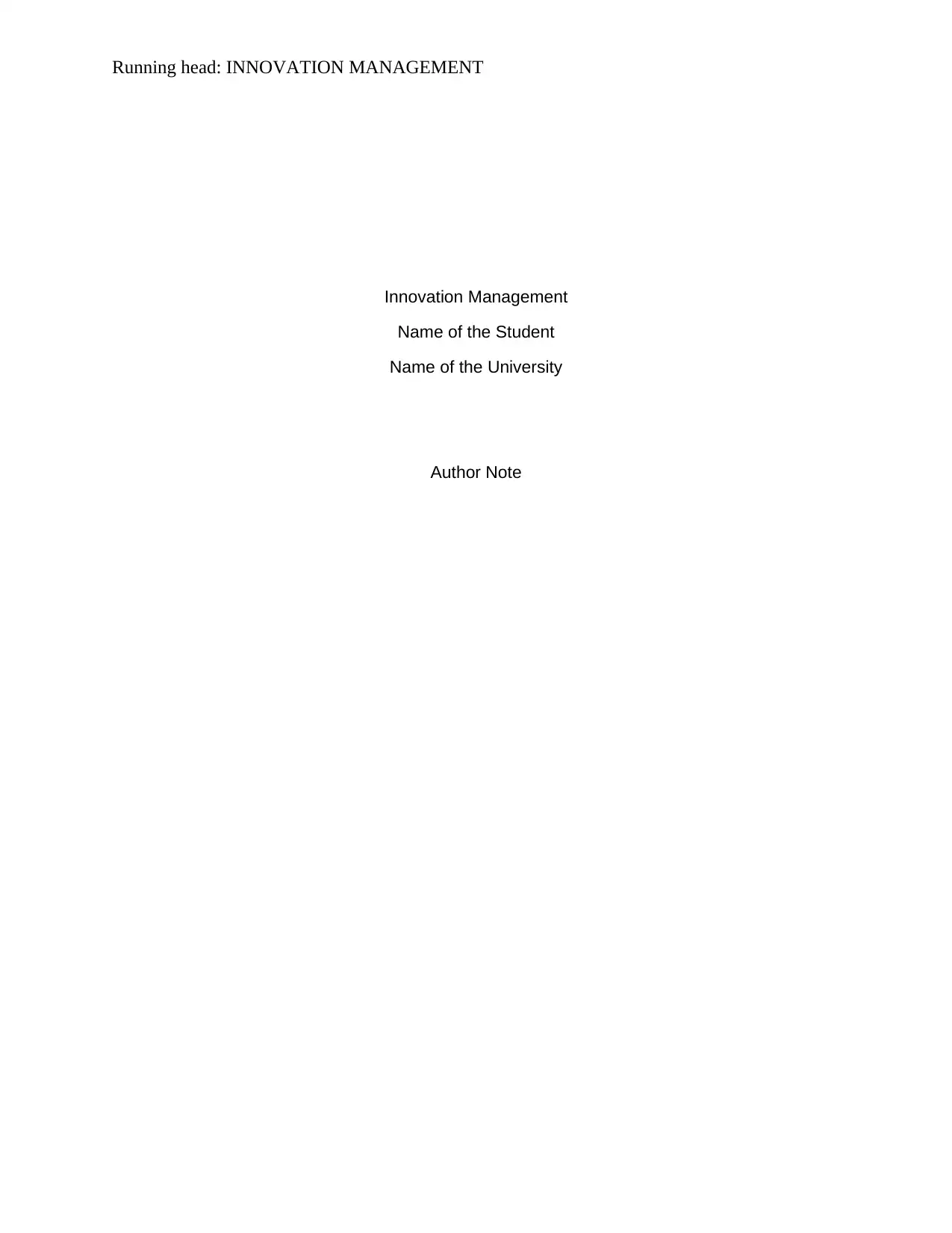
Running head: INNOVATION MANAGEMENT
Innovation Management
Name of the Student
Name of the University
Author Note
Innovation Management
Name of the Student
Name of the University
Author Note
Paraphrase This Document
Need a fresh take? Get an instant paraphrase of this document with our AI Paraphraser
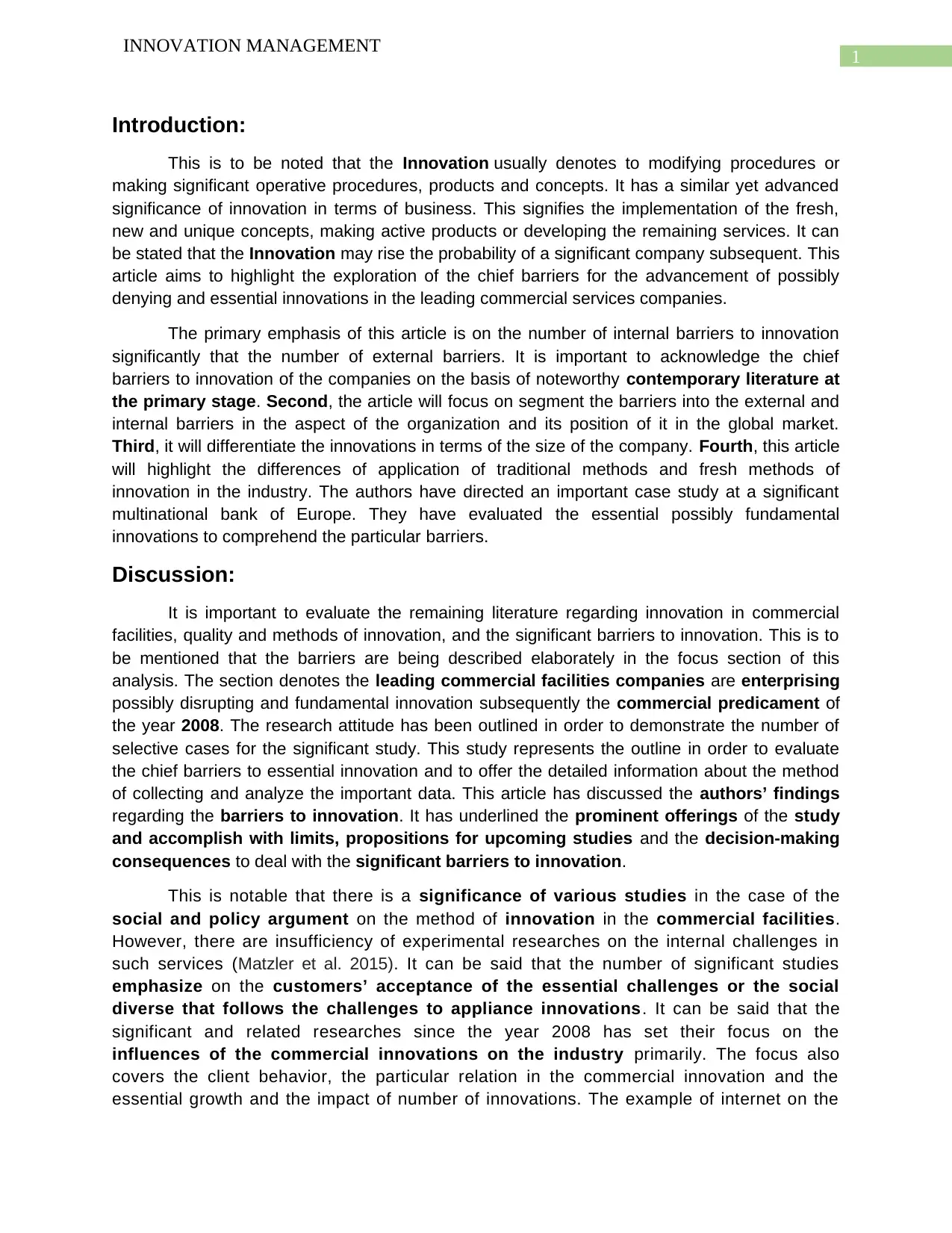
1
INNOVATION MANAGEMENT
Introduction:
This is to be noted that the Innovation usually denotes to modifying procedures or
making significant operative procedures, products and concepts. It has a similar yet advanced
significance of innovation in terms of business. This signifies the implementation of the fresh,
new and unique concepts, making active products or developing the remaining services. It can
be stated that the Innovation may rise the probability of a significant company subsequent. This
article aims to highlight the exploration of the chief barriers for the advancement of possibly
denying and essential innovations in the leading commercial services companies.
The primary emphasis of this article is on the number of internal barriers to innovation
significantly that the number of external barriers. It is important to acknowledge the chief
barriers to innovation of the companies on the basis of noteworthy contemporary literature at
the primary stage. Second, the article will focus on segment the barriers into the external and
internal barriers in the aspect of the organization and its position of it in the global market.
Third, it will differentiate the innovations in terms of the size of the company. Fourth, this article
will highlight the differences of application of traditional methods and fresh methods of
innovation in the industry. The authors have directed an important case study at a significant
multinational bank of Europe. They have evaluated the essential possibly fundamental
innovations to comprehend the particular barriers.
Discussion:
It is important to evaluate the remaining literature regarding innovation in commercial
facilities, quality and methods of innovation, and the significant barriers to innovation. This is to
be mentioned that the barriers are being described elaborately in the focus section of this
analysis. The section denotes the leading commercial facilities companies are enterprising
possibly disrupting and fundamental innovation subsequently the commercial predicament of
the year 2008. The research attitude has been outlined in order to demonstrate the number of
selective cases for the significant study. This study represents the outline in order to evaluate
the chief barriers to essential innovation and to offer the detailed information about the method
of collecting and analyze the important data. This article has discussed the authors’ findings
regarding the barriers to innovation. It has underlined the prominent offerings of the study
and accomplish with limits, propositions for upcoming studies and the decision-making
consequences to deal with the significant barriers to innovation.
This is notable that there is a significance of various studies in the case of the
social and policy argument on the method of innovation in the commercial facilities.
However, there are insufficiency of experimental researches on the internal challenges in
such services (Matzler et al. 2015). It can be said that the number of significant studies
emphasize on the customers’ acceptance of the essential challenges or the social
diverse that follows the challenges to appliance innovations. It can be said that the
significant and related researches since the year 2008 has set their focus on the
influences of the commercial innovations on the industry primarily. The focus also
covers the client behavior, the particular relation in the commercial innovation and the
essential growth and the impact of number of innovations. The example of internet on the
INNOVATION MANAGEMENT
Introduction:
This is to be noted that the Innovation usually denotes to modifying procedures or
making significant operative procedures, products and concepts. It has a similar yet advanced
significance of innovation in terms of business. This signifies the implementation of the fresh,
new and unique concepts, making active products or developing the remaining services. It can
be stated that the Innovation may rise the probability of a significant company subsequent. This
article aims to highlight the exploration of the chief barriers for the advancement of possibly
denying and essential innovations in the leading commercial services companies.
The primary emphasis of this article is on the number of internal barriers to innovation
significantly that the number of external barriers. It is important to acknowledge the chief
barriers to innovation of the companies on the basis of noteworthy contemporary literature at
the primary stage. Second, the article will focus on segment the barriers into the external and
internal barriers in the aspect of the organization and its position of it in the global market.
Third, it will differentiate the innovations in terms of the size of the company. Fourth, this article
will highlight the differences of application of traditional methods and fresh methods of
innovation in the industry. The authors have directed an important case study at a significant
multinational bank of Europe. They have evaluated the essential possibly fundamental
innovations to comprehend the particular barriers.
Discussion:
It is important to evaluate the remaining literature regarding innovation in commercial
facilities, quality and methods of innovation, and the significant barriers to innovation. This is to
be mentioned that the barriers are being described elaborately in the focus section of this
analysis. The section denotes the leading commercial facilities companies are enterprising
possibly disrupting and fundamental innovation subsequently the commercial predicament of
the year 2008. The research attitude has been outlined in order to demonstrate the number of
selective cases for the significant study. This study represents the outline in order to evaluate
the chief barriers to essential innovation and to offer the detailed information about the method
of collecting and analyze the important data. This article has discussed the authors’ findings
regarding the barriers to innovation. It has underlined the prominent offerings of the study
and accomplish with limits, propositions for upcoming studies and the decision-making
consequences to deal with the significant barriers to innovation.
This is notable that there is a significance of various studies in the case of the
social and policy argument on the method of innovation in the commercial facilities.
However, there are insufficiency of experimental researches on the internal challenges in
such services (Matzler et al. 2015). It can be said that the number of significant studies
emphasize on the customers’ acceptance of the essential challenges or the social
diverse that follows the challenges to appliance innovations. It can be said that the
significant and related researches since the year 2008 has set their focus on the
influences of the commercial innovations on the industry primarily. The focus also
covers the client behavior, the particular relation in the commercial innovation and the
essential growth and the impact of number of innovations. The example of internet on the
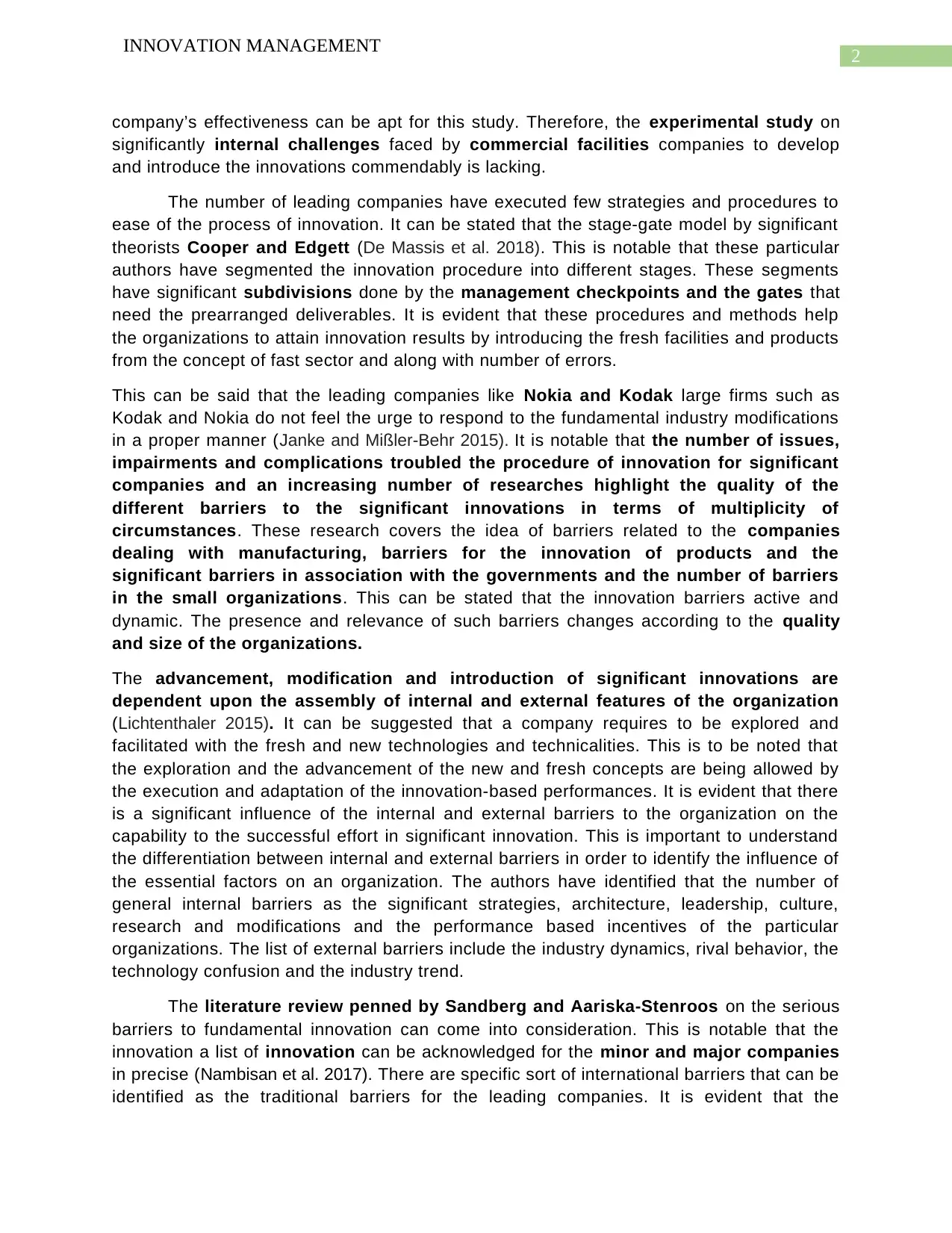
2
INNOVATION MANAGEMENT
company’s effectiveness can be apt for this study. Therefore, the experimental study on
significantly internal challenges faced by commercial facilities companies to develop
and introduce the innovations commendably is lacking.
The number of leading companies have executed few strategies and procedures to
ease of the process of innovation. It can be stated that the stage-gate model by significant
theorists Cooper and Edgett (De Massis et al. 2018). This is notable that these particular
authors have segmented the innovation procedure into different stages. These segments
have significant subdivisions done by the management checkpoints and the gates that
need the prearranged deliverables. It is evident that these procedures and methods help
the organizations to attain innovation results by introducing the fresh facilities and products
from the concept of fast sector and along with number of errors.
This can be said that the leading companies like Nokia and Kodak large firms such as
Kodak and Nokia do not feel the urge to respond to the fundamental industry modifications
in a proper manner (Janke and Mißler-Behr 2015). It is notable that the number of issues,
impairments and complications troubled the procedure of innovation for significant
companies and an increasing number of researches highlight the quality of the
different barriers to the significant innovations in terms of multiplicity of
circumstances. These research covers the idea of barriers related to the companies
dealing with manufacturing, barriers for the innovation of products and the
significant barriers in association with the governments and the number of barriers
in the small organizations. This can be stated that the innovation barriers active and
dynamic. The presence and relevance of such barriers changes according to the quality
and size of the organizations.
The advancement, modification and introduction of significant innovations are
dependent upon the assembly of internal and external features of the organization
(Lichtenthaler 2015). It can be suggested that a company requires to be explored and
facilitated with the fresh and new technologies and technicalities. This is to be noted that
the exploration and the advancement of the new and fresh concepts are being allowed by
the execution and adaptation of the innovation-based performances. It is evident that there
is a significant influence of the internal and external barriers to the organization on the
capability to the successful effort in significant innovation. This is important to understand
the differentiation between internal and external barriers in order to identify the influence of
the essential factors on an organization. The authors have identified that the number of
general internal barriers as the significant strategies, architecture, leadership, culture,
research and modifications and the performance based incentives of the particular
organizations. The list of external barriers include the industry dynamics, rival behavior, the
technology confusion and the industry trend.
The literature review penned by Sandberg and Aariska-Stenroos on the serious
barriers to fundamental innovation can come into consideration. This is notable that the
innovation a list of innovation can be acknowledged for the minor and major companies
in precise (Nambisan et al. 2017). There are specific sort of international barriers that can be
identified as the traditional barriers for the leading companies. It is evident that the
INNOVATION MANAGEMENT
company’s effectiveness can be apt for this study. Therefore, the experimental study on
significantly internal challenges faced by commercial facilities companies to develop
and introduce the innovations commendably is lacking.
The number of leading companies have executed few strategies and procedures to
ease of the process of innovation. It can be stated that the stage-gate model by significant
theorists Cooper and Edgett (De Massis et al. 2018). This is notable that these particular
authors have segmented the innovation procedure into different stages. These segments
have significant subdivisions done by the management checkpoints and the gates that
need the prearranged deliverables. It is evident that these procedures and methods help
the organizations to attain innovation results by introducing the fresh facilities and products
from the concept of fast sector and along with number of errors.
This can be said that the leading companies like Nokia and Kodak large firms such as
Kodak and Nokia do not feel the urge to respond to the fundamental industry modifications
in a proper manner (Janke and Mißler-Behr 2015). It is notable that the number of issues,
impairments and complications troubled the procedure of innovation for significant
companies and an increasing number of researches highlight the quality of the
different barriers to the significant innovations in terms of multiplicity of
circumstances. These research covers the idea of barriers related to the companies
dealing with manufacturing, barriers for the innovation of products and the
significant barriers in association with the governments and the number of barriers
in the small organizations. This can be stated that the innovation barriers active and
dynamic. The presence and relevance of such barriers changes according to the quality
and size of the organizations.
The advancement, modification and introduction of significant innovations are
dependent upon the assembly of internal and external features of the organization
(Lichtenthaler 2015). It can be suggested that a company requires to be explored and
facilitated with the fresh and new technologies and technicalities. This is to be noted that
the exploration and the advancement of the new and fresh concepts are being allowed by
the execution and adaptation of the innovation-based performances. It is evident that there
is a significant influence of the internal and external barriers to the organization on the
capability to the successful effort in significant innovation. This is important to understand
the differentiation between internal and external barriers in order to identify the influence of
the essential factors on an organization. The authors have identified that the number of
general internal barriers as the significant strategies, architecture, leadership, culture,
research and modifications and the performance based incentives of the particular
organizations. The list of external barriers include the industry dynamics, rival behavior, the
technology confusion and the industry trend.
The literature review penned by Sandberg and Aariska-Stenroos on the serious
barriers to fundamental innovation can come into consideration. This is notable that the
innovation a list of innovation can be acknowledged for the minor and major companies
in precise (Nambisan et al. 2017). There are specific sort of international barriers that can be
identified as the traditional barriers for the leading companies. It is evident that the
⊘ This is a preview!⊘
Do you want full access?
Subscribe today to unlock all pages.

Trusted by 1+ million students worldwide
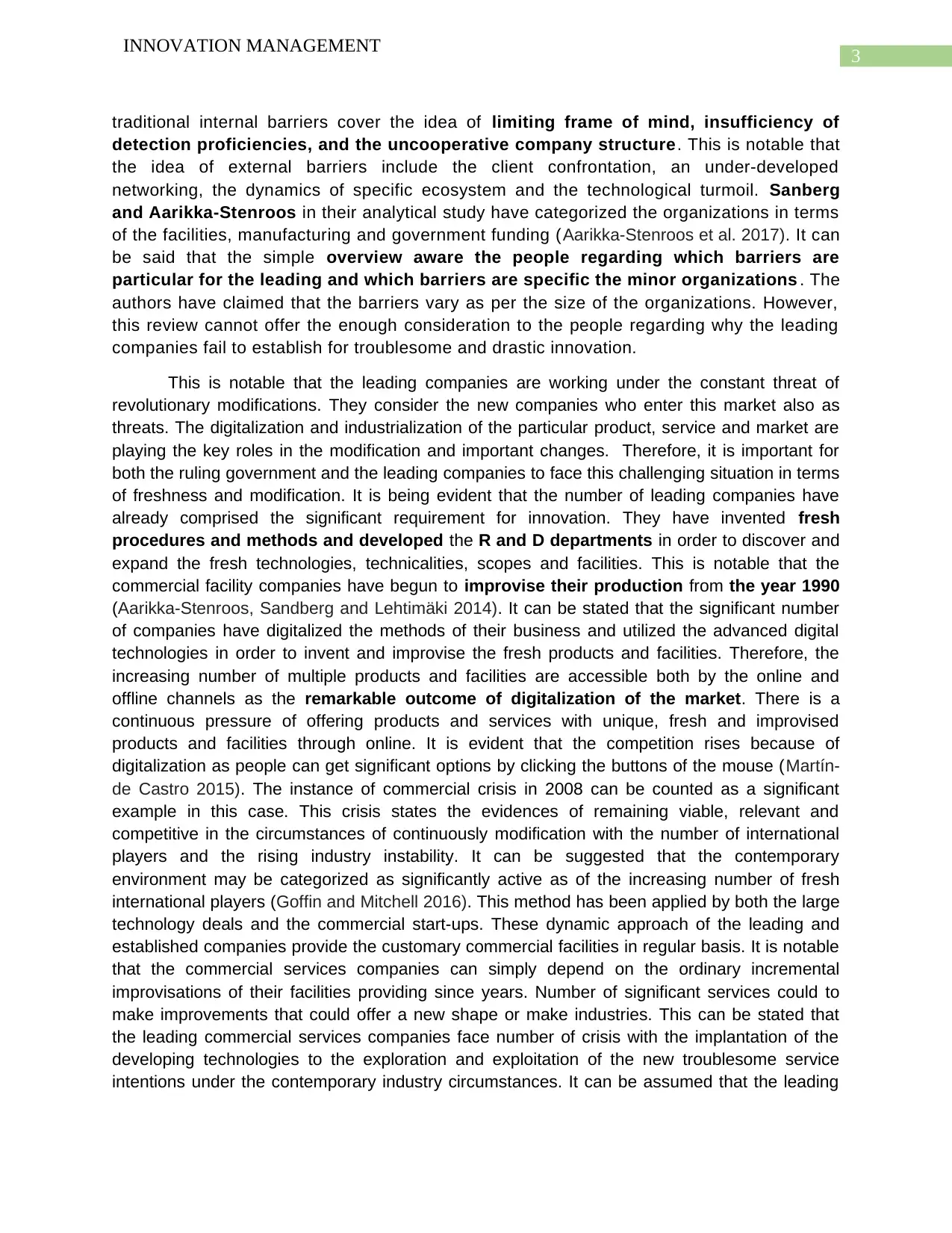
3
INNOVATION MANAGEMENT
traditional internal barriers cover the idea of limiting frame of mind, insufficiency of
detection proficiencies, and the uncooperative company structure. This is notable that
the idea of external barriers include the client confrontation, an under-developed
networking, the dynamics of specific ecosystem and the technological turmoil. Sanberg
and Aarikka-Stenroos in their analytical study have categorized the organizations in terms
of the facilities, manufacturing and government funding (Aarikka-Stenroos et al. 2017). It can
be said that the simple overview aware the people regarding which barriers are
particular for the leading and which barriers are specific the minor organizations . The
authors have claimed that the barriers vary as per the size of the organizations. However,
this review cannot offer the enough consideration to the people regarding why the leading
companies fail to establish for troublesome and drastic innovation.
This is notable that the leading companies are working under the constant threat of
revolutionary modifications. They consider the new companies who enter this market also as
threats. The digitalization and industrialization of the particular product, service and market are
playing the key roles in the modification and important changes. Therefore, it is important for
both the ruling government and the leading companies to face this challenging situation in terms
of freshness and modification. It is being evident that the number of leading companies have
already comprised the significant requirement for innovation. They have invented fresh
procedures and methods and developed the R and D departments in order to discover and
expand the fresh technologies, technicalities, scopes and facilities. This is notable that the
commercial facility companies have begun to improvise their production from the year 1990
(Aarikka-Stenroos, Sandberg and Lehtimäki 2014). It can be stated that the significant number
of companies have digitalized the methods of their business and utilized the advanced digital
technologies in order to invent and improvise the fresh products and facilities. Therefore, the
increasing number of multiple products and facilities are accessible both by the online and
offline channels as the remarkable outcome of digitalization of the market. There is a
continuous pressure of offering products and services with unique, fresh and improvised
products and facilities through online. It is evident that the competition rises because of
digitalization as people can get significant options by clicking the buttons of the mouse (Martín-
de Castro 2015). The instance of commercial crisis in 2008 can be counted as a significant
example in this case. This crisis states the evidences of remaining viable, relevant and
competitive in the circumstances of continuously modification with the number of international
players and the rising industry instability. It can be suggested that the contemporary
environment may be categorized as significantly active as of the increasing number of fresh
international players (Goffin and Mitchell 2016). This method has been applied by both the large
technology deals and the commercial start-ups. These dynamic approach of the leading and
established companies provide the customary commercial facilities in regular basis. It is notable
that the commercial services companies can simply depend on the ordinary incremental
improvisations of their facilities providing since years. Number of significant services could to
make improvements that could offer a new shape or make industries. This can be stated that
the leading commercial services companies face number of crisis with the implantation of the
developing technologies to the exploration and exploitation of the new troublesome service
intentions under the contemporary industry circumstances. It can be assumed that the leading
INNOVATION MANAGEMENT
traditional internal barriers cover the idea of limiting frame of mind, insufficiency of
detection proficiencies, and the uncooperative company structure. This is notable that
the idea of external barriers include the client confrontation, an under-developed
networking, the dynamics of specific ecosystem and the technological turmoil. Sanberg
and Aarikka-Stenroos in their analytical study have categorized the organizations in terms
of the facilities, manufacturing and government funding (Aarikka-Stenroos et al. 2017). It can
be said that the simple overview aware the people regarding which barriers are
particular for the leading and which barriers are specific the minor organizations . The
authors have claimed that the barriers vary as per the size of the organizations. However,
this review cannot offer the enough consideration to the people regarding why the leading
companies fail to establish for troublesome and drastic innovation.
This is notable that the leading companies are working under the constant threat of
revolutionary modifications. They consider the new companies who enter this market also as
threats. The digitalization and industrialization of the particular product, service and market are
playing the key roles in the modification and important changes. Therefore, it is important for
both the ruling government and the leading companies to face this challenging situation in terms
of freshness and modification. It is being evident that the number of leading companies have
already comprised the significant requirement for innovation. They have invented fresh
procedures and methods and developed the R and D departments in order to discover and
expand the fresh technologies, technicalities, scopes and facilities. This is notable that the
commercial facility companies have begun to improvise their production from the year 1990
(Aarikka-Stenroos, Sandberg and Lehtimäki 2014). It can be stated that the significant number
of companies have digitalized the methods of their business and utilized the advanced digital
technologies in order to invent and improvise the fresh products and facilities. Therefore, the
increasing number of multiple products and facilities are accessible both by the online and
offline channels as the remarkable outcome of digitalization of the market. There is a
continuous pressure of offering products and services with unique, fresh and improvised
products and facilities through online. It is evident that the competition rises because of
digitalization as people can get significant options by clicking the buttons of the mouse (Martín-
de Castro 2015). The instance of commercial crisis in 2008 can be counted as a significant
example in this case. This crisis states the evidences of remaining viable, relevant and
competitive in the circumstances of continuously modification with the number of international
players and the rising industry instability. It can be suggested that the contemporary
environment may be categorized as significantly active as of the increasing number of fresh
international players (Goffin and Mitchell 2016). This method has been applied by both the large
technology deals and the commercial start-ups. These dynamic approach of the leading and
established companies provide the customary commercial facilities in regular basis. It is notable
that the commercial services companies can simply depend on the ordinary incremental
improvisations of their facilities providing since years. Number of significant services could to
make improvements that could offer a new shape or make industries. This can be stated that
the leading commercial services companies face number of crisis with the implantation of the
developing technologies to the exploration and exploitation of the new troublesome service
intentions under the contemporary industry circumstances. It can be assumed that the leading
Paraphrase This Document
Need a fresh take? Get an instant paraphrase of this document with our AI Paraphraser
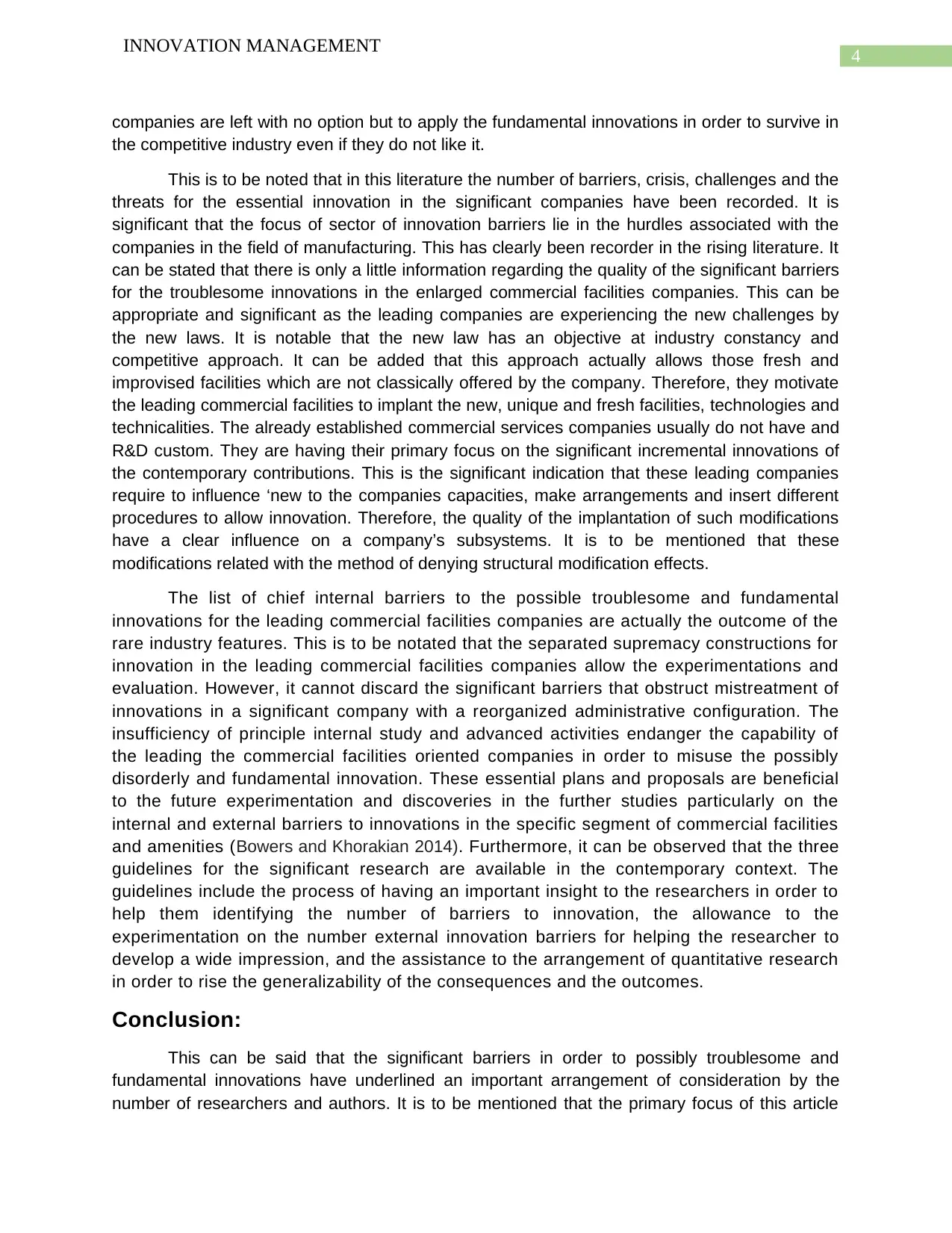
4
INNOVATION MANAGEMENT
companies are left with no option but to apply the fundamental innovations in order to survive in
the competitive industry even if they do not like it.
This is to be noted that in this literature the number of barriers, crisis, challenges and the
threats for the essential innovation in the significant companies have been recorded. It is
significant that the focus of sector of innovation barriers lie in the hurdles associated with the
companies in the field of manufacturing. This has clearly been recorder in the rising literature. It
can be stated that there is only a little information regarding the quality of the significant barriers
for the troublesome innovations in the enlarged commercial facilities companies. This can be
appropriate and significant as the leading companies are experiencing the new challenges by
the new laws. It is notable that the new law has an objective at industry constancy and
competitive approach. It can be added that this approach actually allows those fresh and
improvised facilities which are not classically offered by the company. Therefore, they motivate
the leading commercial facilities to implant the new, unique and fresh facilities, technologies and
technicalities. The already established commercial services companies usually do not have and
R&D custom. They are having their primary focus on the significant incremental innovations of
the contemporary contributions. This is the significant indication that these leading companies
require to influence ‘new to the companies capacities, make arrangements and insert different
procedures to allow innovation. Therefore, the quality of the implantation of such modifications
have a clear influence on a company’s subsystems. It is to be mentioned that these
modifications related with the method of denying structural modification effects.
The list of chief internal barriers to the possible troublesome and fundamental
innovations for the leading commercial facilities companies are actually the outcome of the
rare industry features. This is to be notated that the separated supremacy constructions for
innovation in the leading commercial facilities companies allow the experimentations and
evaluation. However, it cannot discard the significant barriers that obstruct mistreatment of
innovations in a significant company with a reorganized administrative configuration. The
insufficiency of principle internal study and advanced activities endanger the capability of
the leading the commercial facilities oriented companies in order to misuse the possibly
disorderly and fundamental innovation. These essential plans and proposals are beneficial
to the future experimentation and discoveries in the further studies particularly on the
internal and external barriers to innovations in the specific segment of commercial facilities
and amenities (Bowers and Khorakian 2014). Furthermore, it can be observed that the three
guidelines for the significant research are available in the contemporary context. The
guidelines include the process of having an important insight to the researchers in order to
help them identifying the number of barriers to innovation, the allowance to the
experimentation on the number external innovation barriers for helping the researcher to
develop a wide impression, and the assistance to the arrangement of quantitative research
in order to rise the generalizability of the consequences and the outcomes.
Conclusion:
This can be said that the significant barriers in order to possibly troublesome and
fundamental innovations have underlined an important arrangement of consideration by the
number of researchers and authors. It is to be mentioned that the primary focus of this article
INNOVATION MANAGEMENT
companies are left with no option but to apply the fundamental innovations in order to survive in
the competitive industry even if they do not like it.
This is to be noted that in this literature the number of barriers, crisis, challenges and the
threats for the essential innovation in the significant companies have been recorded. It is
significant that the focus of sector of innovation barriers lie in the hurdles associated with the
companies in the field of manufacturing. This has clearly been recorder in the rising literature. It
can be stated that there is only a little information regarding the quality of the significant barriers
for the troublesome innovations in the enlarged commercial facilities companies. This can be
appropriate and significant as the leading companies are experiencing the new challenges by
the new laws. It is notable that the new law has an objective at industry constancy and
competitive approach. It can be added that this approach actually allows those fresh and
improvised facilities which are not classically offered by the company. Therefore, they motivate
the leading commercial facilities to implant the new, unique and fresh facilities, technologies and
technicalities. The already established commercial services companies usually do not have and
R&D custom. They are having their primary focus on the significant incremental innovations of
the contemporary contributions. This is the significant indication that these leading companies
require to influence ‘new to the companies capacities, make arrangements and insert different
procedures to allow innovation. Therefore, the quality of the implantation of such modifications
have a clear influence on a company’s subsystems. It is to be mentioned that these
modifications related with the method of denying structural modification effects.
The list of chief internal barriers to the possible troublesome and fundamental
innovations for the leading commercial facilities companies are actually the outcome of the
rare industry features. This is to be notated that the separated supremacy constructions for
innovation in the leading commercial facilities companies allow the experimentations and
evaluation. However, it cannot discard the significant barriers that obstruct mistreatment of
innovations in a significant company with a reorganized administrative configuration. The
insufficiency of principle internal study and advanced activities endanger the capability of
the leading the commercial facilities oriented companies in order to misuse the possibly
disorderly and fundamental innovation. These essential plans and proposals are beneficial
to the future experimentation and discoveries in the further studies particularly on the
internal and external barriers to innovations in the specific segment of commercial facilities
and amenities (Bowers and Khorakian 2014). Furthermore, it can be observed that the three
guidelines for the significant research are available in the contemporary context. The
guidelines include the process of having an important insight to the researchers in order to
help them identifying the number of barriers to innovation, the allowance to the
experimentation on the number external innovation barriers for helping the researcher to
develop a wide impression, and the assistance to the arrangement of quantitative research
in order to rise the generalizability of the consequences and the outcomes.
Conclusion:
This can be said that the significant barriers in order to possibly troublesome and
fundamental innovations have underlined an important arrangement of consideration by the
number of researchers and authors. It is to be mentioned that the primary focus of this article
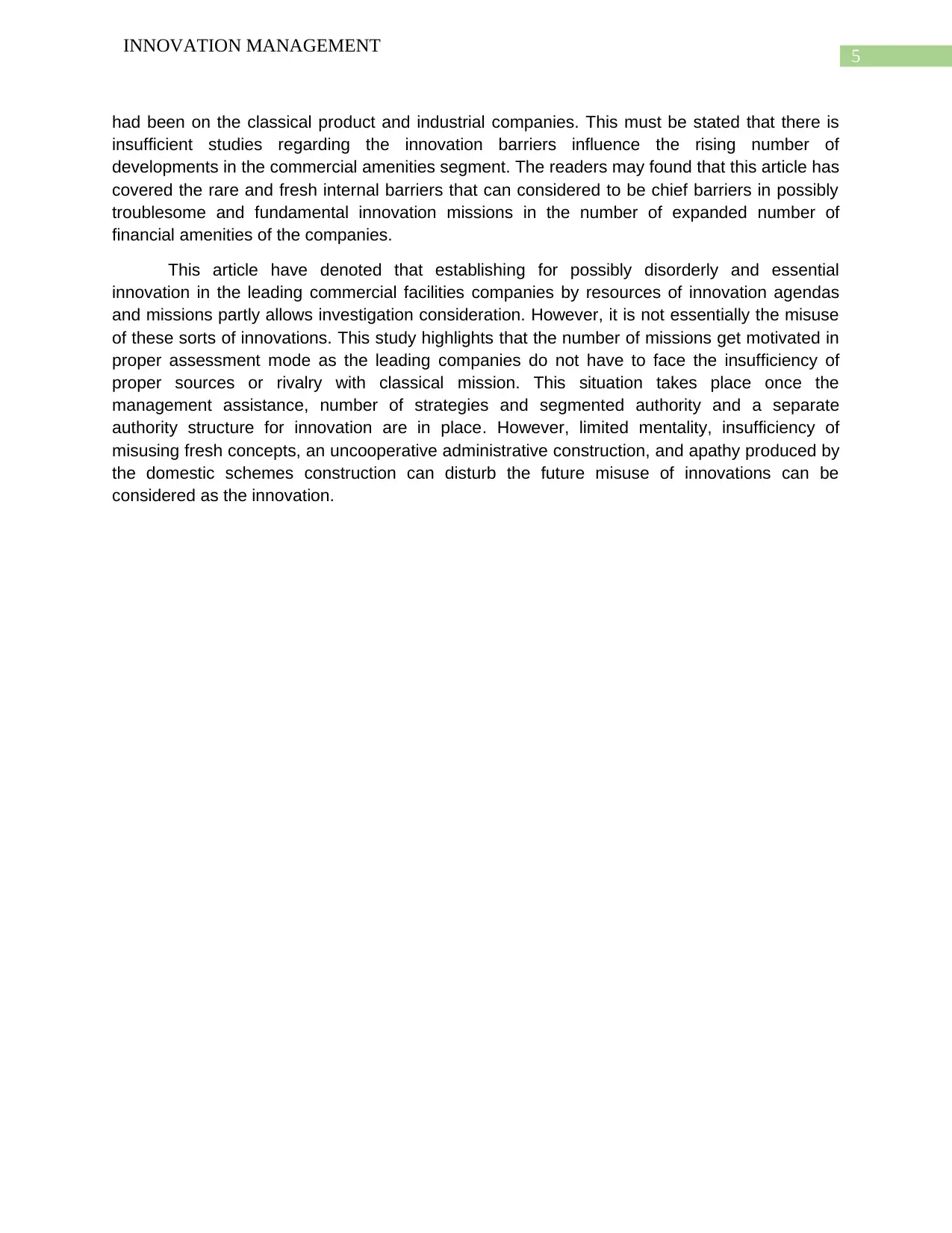
5
INNOVATION MANAGEMENT
had been on the classical product and industrial companies. This must be stated that there is
insufficient studies regarding the innovation barriers influence the rising number of
developments in the commercial amenities segment. The readers may found that this article has
covered the rare and fresh internal barriers that can considered to be chief barriers in possibly
troublesome and fundamental innovation missions in the number of expanded number of
financial amenities of the companies.
This article have denoted that establishing for possibly disorderly and essential
innovation in the leading commercial facilities companies by resources of innovation agendas
and missions partly allows investigation consideration. However, it is not essentially the misuse
of these sorts of innovations. This study highlights that the number of missions get motivated in
proper assessment mode as the leading companies do not have to face the insufficiency of
proper sources or rivalry with classical mission. This situation takes place once the
management assistance, number of strategies and segmented authority and a separate
authority structure for innovation are in place. However, limited mentality, insufficiency of
misusing fresh concepts, an uncooperative administrative construction, and apathy produced by
the domestic schemes construction can disturb the future misuse of innovations can be
considered as the innovation.
INNOVATION MANAGEMENT
had been on the classical product and industrial companies. This must be stated that there is
insufficient studies regarding the innovation barriers influence the rising number of
developments in the commercial amenities segment. The readers may found that this article has
covered the rare and fresh internal barriers that can considered to be chief barriers in possibly
troublesome and fundamental innovation missions in the number of expanded number of
financial amenities of the companies.
This article have denoted that establishing for possibly disorderly and essential
innovation in the leading commercial facilities companies by resources of innovation agendas
and missions partly allows investigation consideration. However, it is not essentially the misuse
of these sorts of innovations. This study highlights that the number of missions get motivated in
proper assessment mode as the leading companies do not have to face the insufficiency of
proper sources or rivalry with classical mission. This situation takes place once the
management assistance, number of strategies and segmented authority and a separate
authority structure for innovation are in place. However, limited mentality, insufficiency of
misusing fresh concepts, an uncooperative administrative construction, and apathy produced by
the domestic schemes construction can disturb the future misuse of innovations can be
considered as the innovation.
⊘ This is a preview!⊘
Do you want full access?
Subscribe today to unlock all pages.

Trusted by 1+ million students worldwide
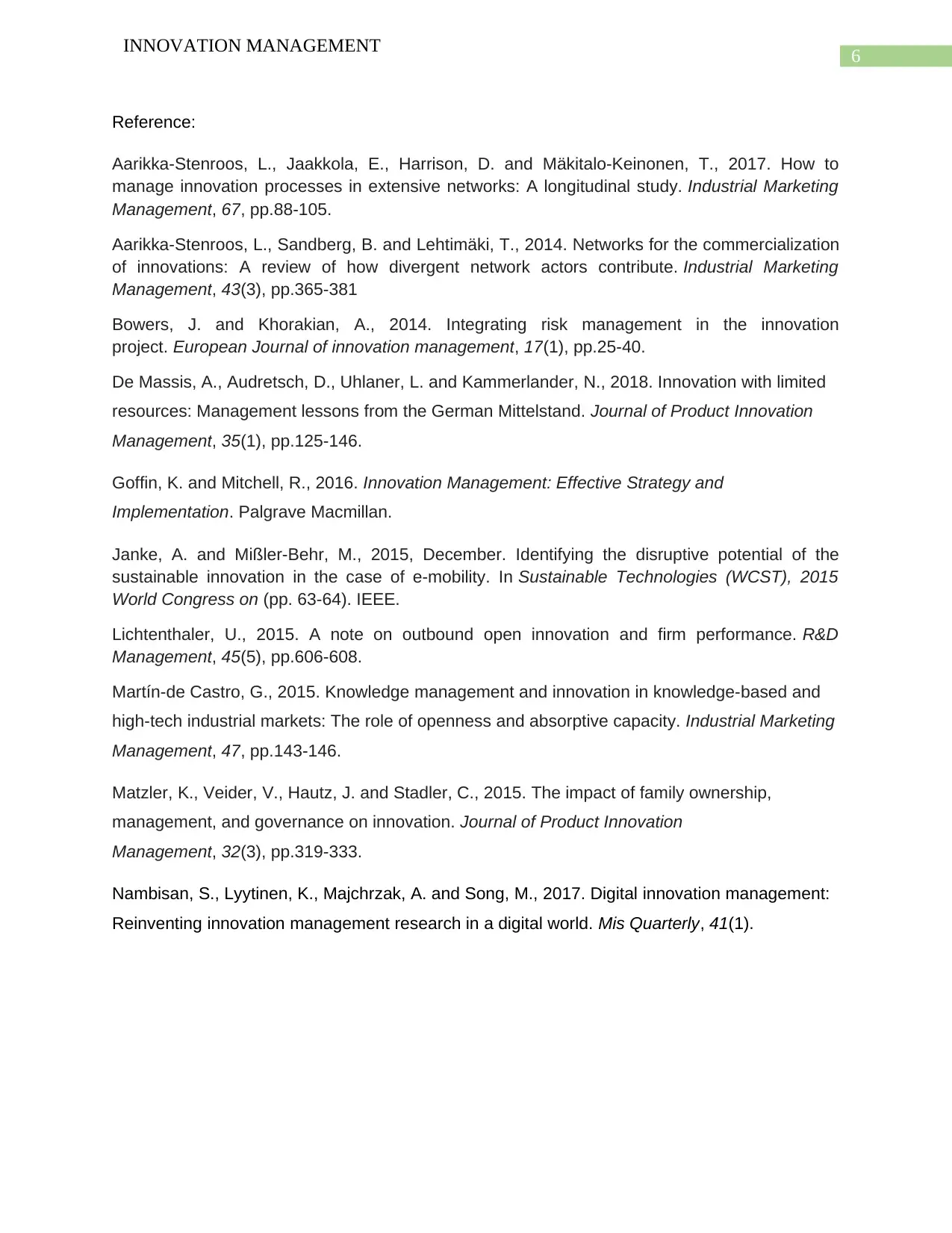
6
INNOVATION MANAGEMENT
Reference:
Aarikka-Stenroos, L., Jaakkola, E., Harrison, D. and Mäkitalo-Keinonen, T., 2017. How to
manage innovation processes in extensive networks: A longitudinal study. Industrial Marketing
Management, 67, pp.88-105.
Aarikka-Stenroos, L., Sandberg, B. and Lehtimäki, T., 2014. Networks for the commercialization
of innovations: A review of how divergent network actors contribute. Industrial Marketing
Management, 43(3), pp.365-381
Bowers, J. and Khorakian, A., 2014. Integrating risk management in the innovation
project. European Journal of innovation management, 17(1), pp.25-40.
De Massis, A., Audretsch, D., Uhlaner, L. and Kammerlander, N., 2018. Innovation with limited
resources: Management lessons from the German Mittelstand. Journal of Product Innovation
Management, 35(1), pp.125-146.
Goffin, K. and Mitchell, R., 2016. Innovation Management: Effective Strategy and
Implementation. Palgrave Macmillan.
Janke, A. and Mißler-Behr, M., 2015, December. Identifying the disruptive potential of the
sustainable innovation in the case of e-mobility. In Sustainable Technologies (WCST), 2015
World Congress on (pp. 63-64). IEEE.
Lichtenthaler, U., 2015. A note on outbound open innovation and firm performance. R&D
Management, 45(5), pp.606-608.
Martín-de Castro, G., 2015. Knowledge management and innovation in knowledge-based and
high-tech industrial markets: The role of openness and absorptive capacity. Industrial Marketing
Management, 47, pp.143-146.
Matzler, K., Veider, V., Hautz, J. and Stadler, C., 2015. The impact of family ownership,
management, and governance on innovation. Journal of Product Innovation
Management, 32(3), pp.319-333.
Nambisan, S., Lyytinen, K., Majchrzak, A. and Song, M., 2017. Digital innovation management:
Reinventing innovation management research in a digital world. Mis Quarterly, 41(1).
INNOVATION MANAGEMENT
Reference:
Aarikka-Stenroos, L., Jaakkola, E., Harrison, D. and Mäkitalo-Keinonen, T., 2017. How to
manage innovation processes in extensive networks: A longitudinal study. Industrial Marketing
Management, 67, pp.88-105.
Aarikka-Stenroos, L., Sandberg, B. and Lehtimäki, T., 2014. Networks for the commercialization
of innovations: A review of how divergent network actors contribute. Industrial Marketing
Management, 43(3), pp.365-381
Bowers, J. and Khorakian, A., 2014. Integrating risk management in the innovation
project. European Journal of innovation management, 17(1), pp.25-40.
De Massis, A., Audretsch, D., Uhlaner, L. and Kammerlander, N., 2018. Innovation with limited
resources: Management lessons from the German Mittelstand. Journal of Product Innovation
Management, 35(1), pp.125-146.
Goffin, K. and Mitchell, R., 2016. Innovation Management: Effective Strategy and
Implementation. Palgrave Macmillan.
Janke, A. and Mißler-Behr, M., 2015, December. Identifying the disruptive potential of the
sustainable innovation in the case of e-mobility. In Sustainable Technologies (WCST), 2015
World Congress on (pp. 63-64). IEEE.
Lichtenthaler, U., 2015. A note on outbound open innovation and firm performance. R&D
Management, 45(5), pp.606-608.
Martín-de Castro, G., 2015. Knowledge management and innovation in knowledge-based and
high-tech industrial markets: The role of openness and absorptive capacity. Industrial Marketing
Management, 47, pp.143-146.
Matzler, K., Veider, V., Hautz, J. and Stadler, C., 2015. The impact of family ownership,
management, and governance on innovation. Journal of Product Innovation
Management, 32(3), pp.319-333.
Nambisan, S., Lyytinen, K., Majchrzak, A. and Song, M., 2017. Digital innovation management:
Reinventing innovation management research in a digital world. Mis Quarterly, 41(1).
1 out of 7
Related Documents
Your All-in-One AI-Powered Toolkit for Academic Success.
+13062052269
info@desklib.com
Available 24*7 on WhatsApp / Email
![[object Object]](/_next/static/media/star-bottom.7253800d.svg)
Unlock your academic potential
Copyright © 2020–2025 A2Z Services. All Rights Reserved. Developed and managed by ZUCOL.




